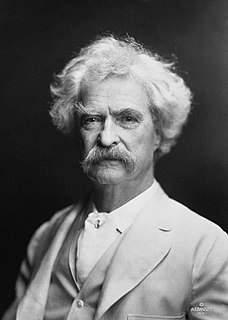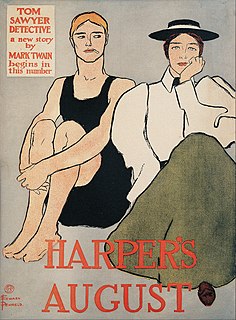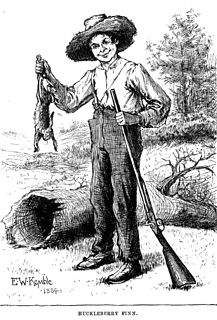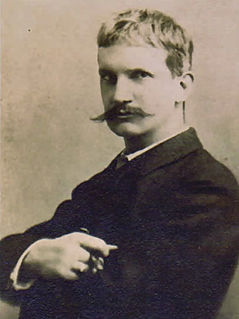
Adventures of Huckleberry Finn or as it is known in more recent editions, The Adventures of Huckleberry Finn, is a novel by American author Mark Twain, which was first published in the United Kingdom in December 1884 and in the United States in February 1885.

Samuel Langhorne Clemens, known by his pen name Mark Twain, was an American writer, humorist, entrepreneur, publisher, and lecturer. He was lauded as the "greatest humorist the United States has produced", and William Faulkner called him "the father of American literature". His novels include The Adventures of Tom Sawyer (1876) and its sequel, Adventures of Huckleberry Finn (1884), the latter of which has often been called the "Great American Novel".

Roughing It is a book of semi-autobiographical travel literature by Mark Twain. It was written in 1870–71 and published in 1872, as a prequel to his first travel book The Innocents Abroad (1869). Roughing It is dedicated to Twain's mining companion Calvin H. Higbie, later a civil engineer who died in 1914.

Tom Sawyer, Detective is an 1896 novel by Mark Twain. It is a sequel to The Adventures of Tom Sawyer (1876), Adventures of Huckleberry Finn (1884), and Tom Sawyer Abroad (1894). Tom Sawyer attempts to solve a mysterious murder in this burlesque of the immensely popular detective novels of the time. Like Adventures of Huckleberry Finn, the story is told using the first-person narrative voice of Huck Finn.

The Doe Memorial Library is the main library of the University of California, Berkeley Library System. The library is named after its benefactor, Charles Franklin Doe, who in 1904 bequeathed funds for its construction. It is located near the center of the Berkeley campus, facing Memorial Glade, and is adjacent to and physically connected with the Bancroft Library. In 1900, Emile Benard won an architectural competition for the design of the library, and the Neoclassical-style building was completed in 1911. The Doe Library building is the gateway to the underground Gardner (Main) Stacks, named in honor of David P. Gardner, the 15th President of the University of California.

The Adventures of Mark Twain is a 1944 American biographical film directed by Irving Rapper and starring Fredric March as Samuel Clemens and Alexis Smith as Twain's wife Olivia. Produced by Warner Bros., the film was nominated for three Academy Awards, including that for Best Music for Max Steiner's score. Irving Rapper was hesitant to direct the film but was persuaded by Hal B. Wallis.

The Mark Twain Boyhood Home & Museum is located on 206-208 Hill Street, Hannibal, Missouri, on the west bank of the Mississippi River in the United States. It was the home of Samuel Langhorne Clemens, better known as author Mark Twain, from 1844 to 1853. Clemens found the inspiration for many of his stories, including the white picket fence, while living here. It has been open to the public as a museum since 1912, and was designated a National Historic Landmark on December 29, 1962. It is located in the Mark Twain Historic District.

Mark Twain's legacy includes awards, events, a variety of memorials and namesakes, and numerous works of art, entertainment, and media.

Edward Winsor Kemble, usually cited as E. W. Kemble, and sometimes referred to incorrectly as Edward Windsor Kemble, was an American illustrator. He is known best for illustrating the first edition of Adventures of Huckleberry Finn and for his caricatures of African Americans.

Huckleberry "Huck" Finn is a fictional character created by Mark Twain who first appeared in the book The Adventures of Tom Sawyer (1876) and is the protagonist and narrator of its sequel, Adventures of Huckleberry Finn (1884). He is 12 or 13 years old during the former and a year older at the time of the latter. Huck also narrates Tom Sawyer Abroad and Tom Sawyer, Detective, two shorter sequels to the first two books.
George Griffin was an African-American born into slavery in Virginia in 1849. In 1874, as a free man, Griffin came to work for Samuel L. Clemens. Details of Griffin's early life remain largely unknown. But there is much information about Griffin's later life, primarily from Clemens's letters and unpublished memoirs. For example, according to Clemens' unpublished manuscript A Family Sketch, Griffin "was a Maryland slave by birth; the Proclamation set him free, & as a young fellow he saw his fair share of the Civil War as body servant to General Devens".

The texas is a structure or section of a steamboat that includes the crew's quarters. It is located on the hurricane deck, which is also called the texas deck. This long, narrow cabin is near and may be surmounted by the pilothouse.

Karl Gerhardt was a United States sculptor, best known for his death mask of President Ulysses S. Grant and a portrait bust of Mark Twain.
Paico Classics, also Paico Classics Illustrated, was a series of Indian comic books published by Pai and Company (PAICO), Cochin between April 1984 and December 1988. The series were the reprints of "Pendulum Illustrated Classics" translated into various Indian languages. R. Gopalakrishnan, also associated with the Poompatta children's magazine, was the editor of Paico Classics.

The Mark Twain House and Museum in Hartford, Connecticut, was the home of Samuel Langhorne Clemens and his family from 1874 to 1891. It was designed by Edward Tuckerman Potter and built in the American High Gothic style. Clemens biographer Justin Kaplan has called it "part steamboat, part medieval fortress and part cuckoo clock."

After eight years in the presidential office during Reconstruction, Ulysses S. Grant looked forward to retirement from public life. When his second term in office ended in March 1877, Grant had gained weight, while he desired to travel the world and visit his daughter in Scotland. Grant began his post-presidential life with a two-year tour that took him and his wife and entourage around the world. On returning, Grant was welcomed home with an adoration unknown since the end of the Civil War, and he began to consider running for a third term as president in 1880. Following a hard-fought defeat at the Republican National Convention that year, Grant embarked on a financial career in partnership with Ferdinand Ward, but the venture failed and Grant was nearly bankrupted. Diagnosed with cancer in 1884, he began writing his memoirs as a way to tell his story and provide for his family after his death. The book, finished just before his death the following year, was a huge success and remains in print. Grant was interred in Grant's Tomb, a massive mausoleum in New York City.
In September 2003, Barnes & Noble Books of New York began to publish The Collector's Library series of some of the world's most notable literary works. By October 2005, fifty-nine volumes had been printed. Each unabridged volume is book size octodecimo, or 4 x 6-1/2 inches, printed in hardback, on high-quality paper, bound in real cloth, and contains a dust jacket. In 2015, The Collector's Library was acquired by Pan Macmillan.
Charles Neider was an American writer, known for editing the Autobiography of Mark Twain and authoring literary impressions of Antarctica.
The Center For Mark Twain Studies is a cultural humanities site associated with Elmira College. The Center manages two historic sites, the Octagonal Study and Quarry Farm, where the American author, Mark Twain, composed many of his works, including Adventures of Huckleberry Finn. The center also includes exhibits and archives. It administers research fellowships and delivers extensive programming, including lectures series, symposia, teachers institutes, digital resources, podcasts, and the quadrennial International Conference on the State of Mark Twain Studies.















